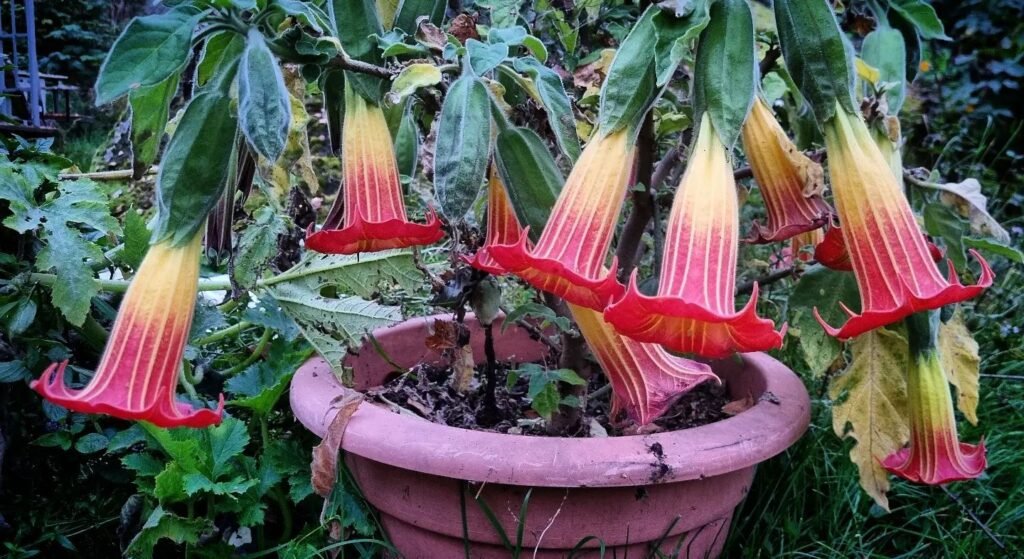Imagine strolling through your garden, enveloped in a symphony of vibrant colours and intoxicating fragrance. The air is filled with the sweet scent of Brugmansia sanguinea, also known as Red Angel’s Trumpet, enticing you closer with its trumpet-shaped flowers. As a gardening enthusiast in the UK, I have discovered the pure joy of growing Brugmansia sanguinea, transforming my garden into a tropical paradise.
Appearance of Brugmansia sanguinea
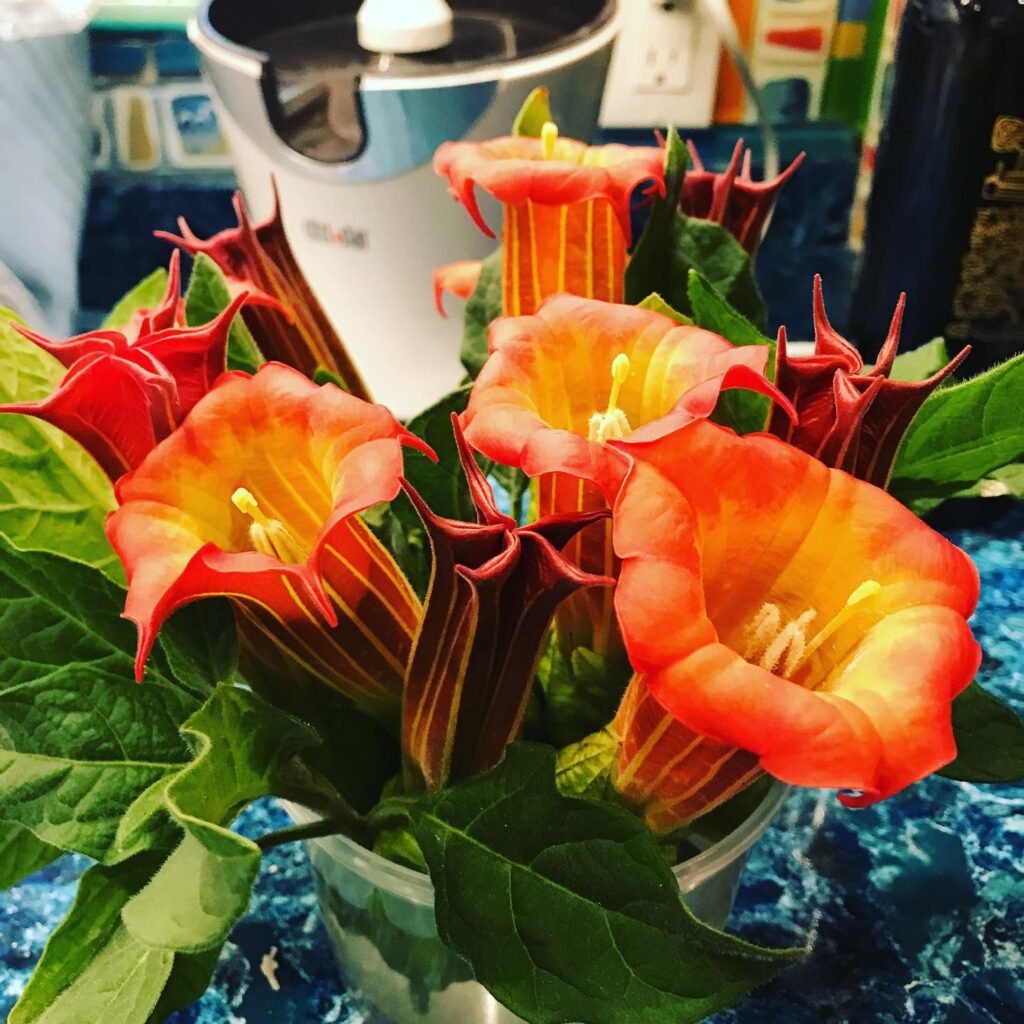
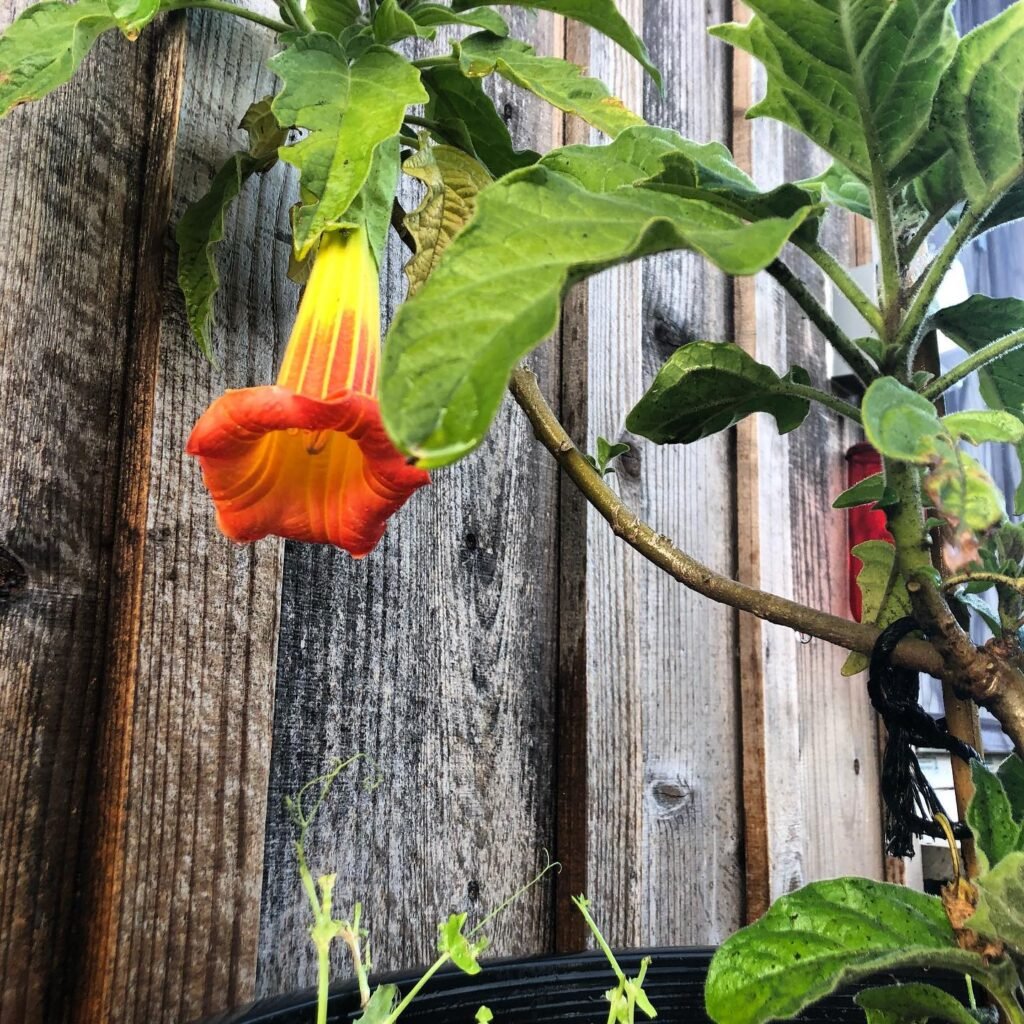
Brugmansia sanguinea, also known as Red Angel’s Trumpet, is a vigorous evergreen shrub or small tree that can reach heights of at least 2 meters. It is characterized by its large trumpet-shaped flowers, which can grow up to 30cm in length. The flowers come in shades of red and are highly fragrant, especially in the evening. The plant’s leaves are lush and green, adding to its ornamental appeal in the garden.
Brugmansia sanguinea showcases its stunning trumpet-shaped flowers that can grow as long as 30cm. These vibrant blooms, with their red hues, bring a pop of color to any garden. Along with its mesmerizing appearance, this plant emits a delightful fragrance, particularly during the evenings. The combination of its lush foliage and striking flowers makes Brugmansia sanguinea a standout addition to any garden or landscape.
However, it’s crucial to note that all parts of Brugmansia sanguinea are highly poisonous. It’s important to exercise caution when handling this plant, wearing gloves and ensuring it’s out of reach of children and pets.
 The Brugmansia sanguinea (Red Angel’s Trumpet) is integral to cultural and spiritual practices in South America. Used in traditional ceremonies and healing for centuries due to its hallucinogenic alkaloids, it facilitates spiritual visions. Yet, caution is advised as all parts are toxic and should not be ingested.
The Brugmansia sanguinea (Red Angel’s Trumpet) is integral to cultural and spiritual practices in South America. Used in traditional ceremonies and healing for centuries due to its hallucinogenic alkaloids, it facilitates spiritual visions. Yet, caution is advised as all parts are toxic and should not be ingested.
Light Requirements for Brugmansia sanguinea
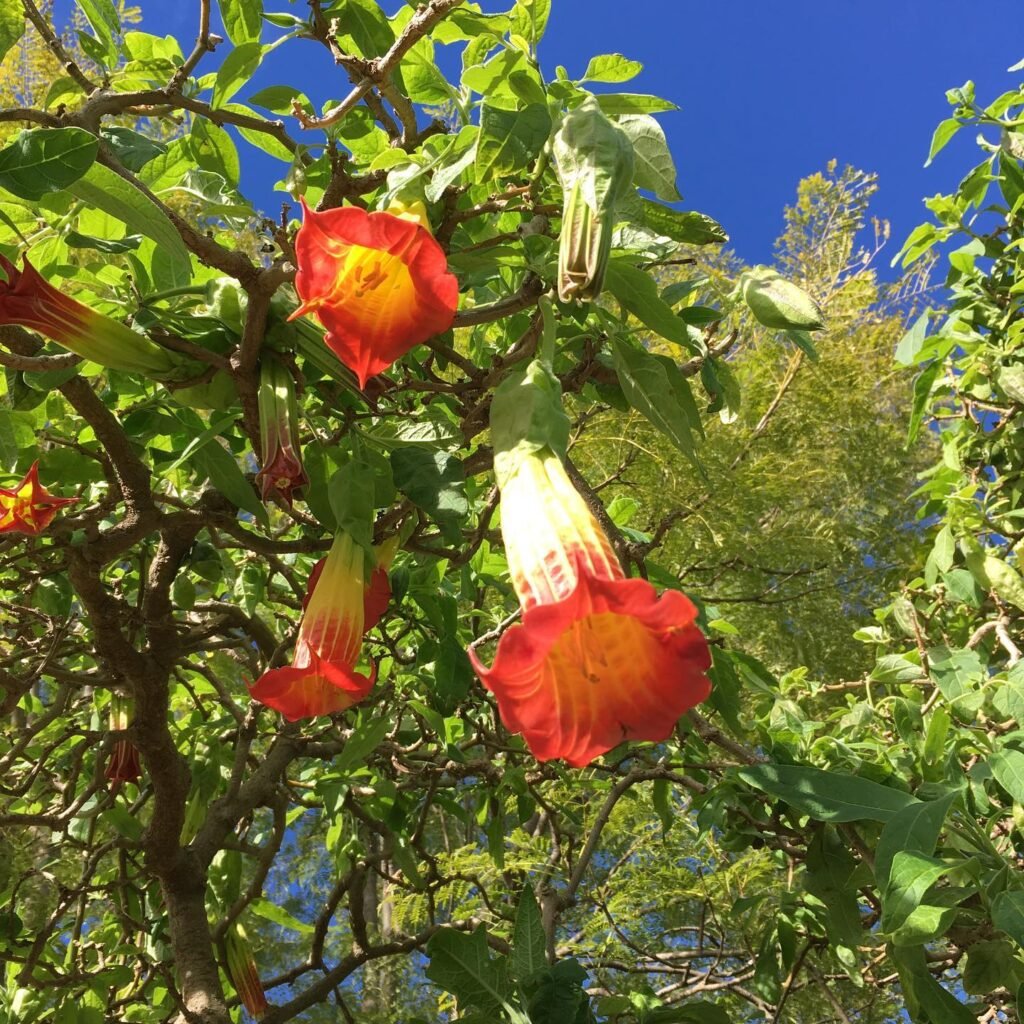
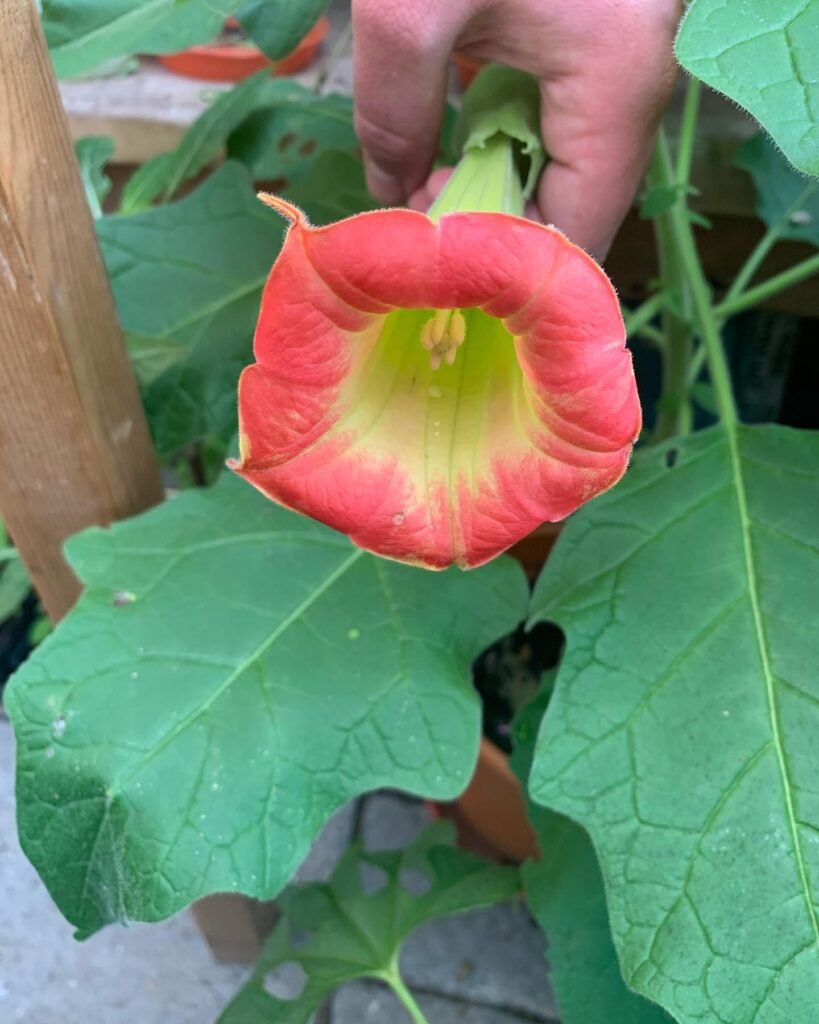
Brugmansia sanguinea, commonly known as Red Angel’s Trumpet, thrives in bright light. When growing this tropical beauty indoors, it’s important to place the plant in a location that receives ample sunlight. I recommend placing it in a conservatory or beside a large sunny window, as these areas provide the necessary light intensity for optimal growth.
If you prefer to grow Brugmansia sanguinea outdoors, choose a warm and sheltered spot in your garden. This will allow the plant to receive both partial shade and direct sunlight throughout the day. The combination of these light conditions will ensure that your Red Angel’s Trumpet flourishes.
It’s worth noting that Brugmansia sanguinea can also be successfully grown indoors year-round, as long as it receives sufficient bright light. In indoor environments, it’s crucial to replicate the plant’s natural light requirements to promote healthy growth and abundant flowering.

Watering Tips for Red Angel’s Trumpet


Brugmansia sanguinea, known as the Red Angel’s Trumpet, requires careful attention to its watering needs to thrive. During the growing season, from spring to autumn, it is essential to provide the plant with regular and generous watering. As an enthusiastic grower, I have found that watering the plant at least once a day is crucial for its well-being. In hotter spells, when the weather is scorching, it may even require watering twice a day to prevent dehydration.
When growing Brugmansia sanguinea in containers, it is essential to keep an eye on the moisture levels in the soil. Due to the limited amount of soil in pots, the compost can dry out quickly, leaving the plant thirsty. Therefore, it is advisable to check the soil regularly and water whenever it feels dry to the touch.
While Brugmansia sanguinea has a high watering requirement, it is crucial to ensure that the soil has good drainage. Stagnant water can lead to waterlogging, which can be detrimental to the plant’s health. Therefore, choosing well-drained soil is vital for preventing water accumulation and allowing excess water to escape, creating a suitable environment for the Red Angel’s Trumpet to thrive.
In summary, to care for Brugmansia sanguinea and provide it with the hydration it needs, it’s best to water the plant regularly during the growing season, at least once a day but possibly even twice a day in hot weather. Keep an eye on the moisture levels in the soil, especially in containers, and ensure proper drainage to avoid waterlogging. By following these watering tips, you can help your Red Angel’s Trumpet flourish and enjoy its vibrant beauty throughout the season.

Fertilizing and Soil for Brugmansia sanguinea
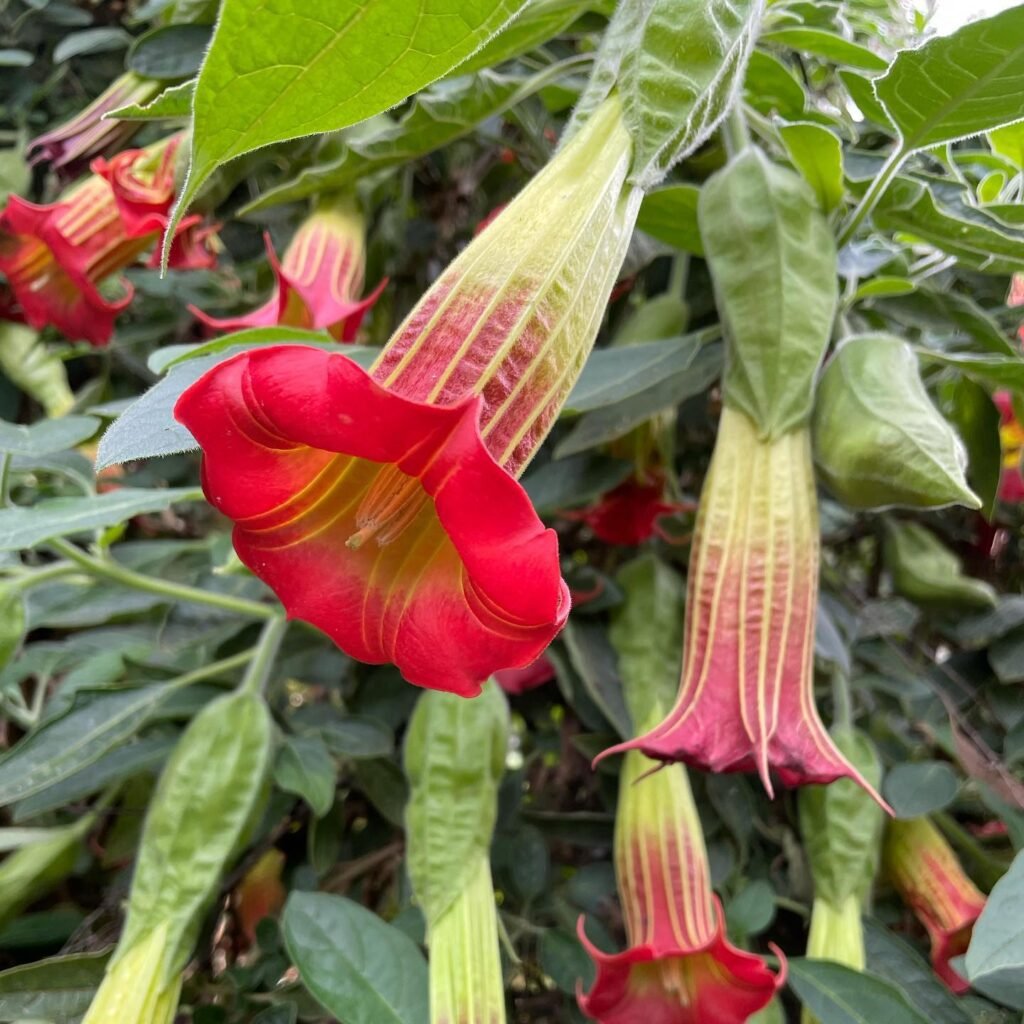
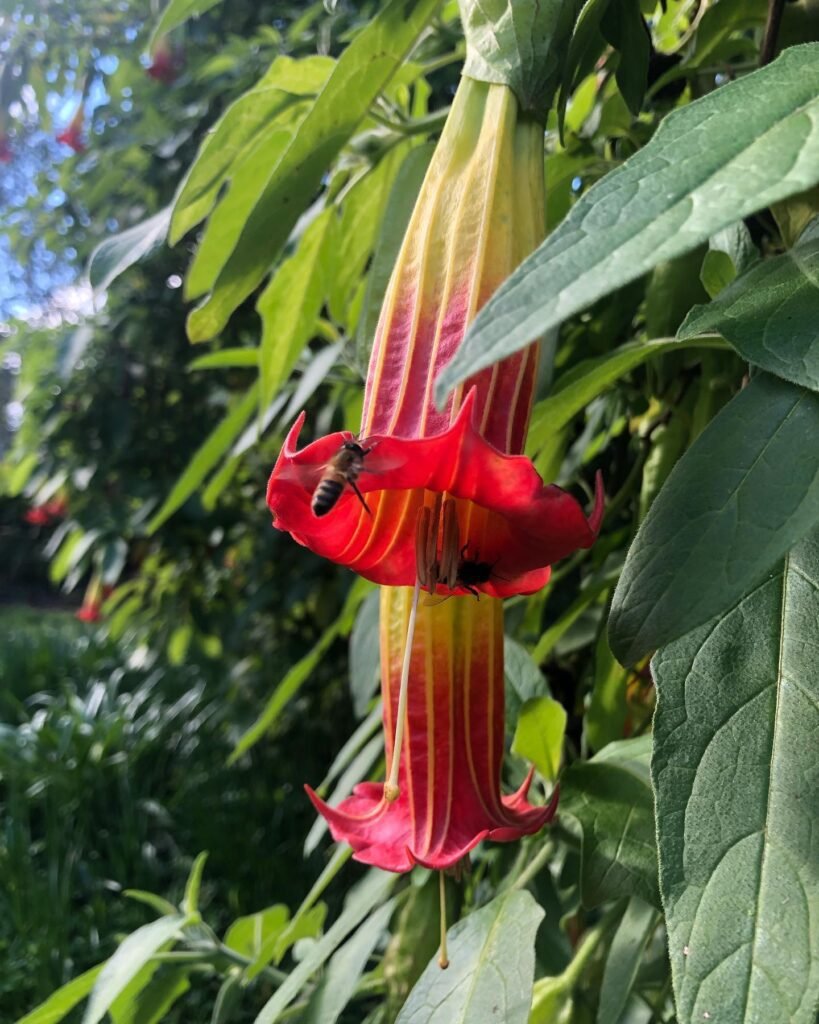
Brugmansia sanguinea (Red Angel’s Trumpet), thrives with regular fertilization to promote robust growth and abundant flowering. To support the plant’s nutritional needs, there are some fertilizing tips to keep in mind.
In spring, I recommend applying a balanced liquid fertilizer once a month. This will provide the necessary nutrients for strong growth and overall health. It’s important to choose a fertilizer specifically formulated for flowering plants, as Brugmansia sanguinea is known for its stunning trumpet-shaped flowers.
To encourage blooming during the summer months, I suggest using a high-potassium feed, such as tomato fertilizer. This can be applied at least once a week to stimulate flower production. The increased potassium content will promote vibrant and long-lasting blooms, adding a touch of beauty to your garden.
When it comes to the soil requirements for Brugmansia sanguinea, using the right mixture will greatly benefit the plant’s growth. When planting, I recommend using a 50:50 mix of ordinary multipurpose compost and John Innes No. 3 compost.
This combination provides excellent water and nutrient retention, ensuring that the soil remains consistently moist and fertile. Brugmansia sanguinea appreciates a rich and moist soil environment, allowing its roots to absorb the necessary nutrients for healthy development.

Pruning and Maintenance for Red Angel’s Trumpet


Pruning and maintenance are crucial for the health and well-being of Brugmansia sanguinea, also known as Red Angel’s Trumpet. To keep this stunning plant in shape, it is recommended to prune it in late summer, especially if you have limited space indoors. When pruning, be sure to cut back the stems to within a few centimeters of old wood, just above a node. Remember to wear gloves throughout the process, as all parts of the plant are highly toxic.
In addition to pruning, regular maintenance is essential to ensure the overall vitality of your Brugmansia sanguinea. This includes watering, feeding, and staying vigilant against pests and diseases. Proper watering is crucial, especially during the growing season, from spring to autumn. The plant requires generous and regular watering, ideally once or twice a day during hot spells. However, it is important to ensure the soil is well-drained to avoid waterlogging.
Feeding your Red Angel’s Trumpet is also important for its growth and flowering. Consider using a balanced liquid fertilizer in spring to promote robust growth, and switch to a high-potassium feed, such as tomato fertilizer, during summer to encourage abundant blooms.
Monitoring the plant for pests and diseases is crucial to maintain its health. Keep an eye out for common pests like aphids, mealybugs, and spider mites. If detected, take appropriate measures to control the infestation immediately.
To keep Brugmansia sanguinea healthy and flourishing, regular pruning and maintenance are key. Prune in late summer, wear gloves for protection, and maintain a routine of watering, feeding, and monitoring for pests. By investing time in proper care, you’ll enjoy the beauty of your Red Angel’s Trumpet for years to come.

Propagating Brugmansia sanguinea (Red Angel’s Trumpet)

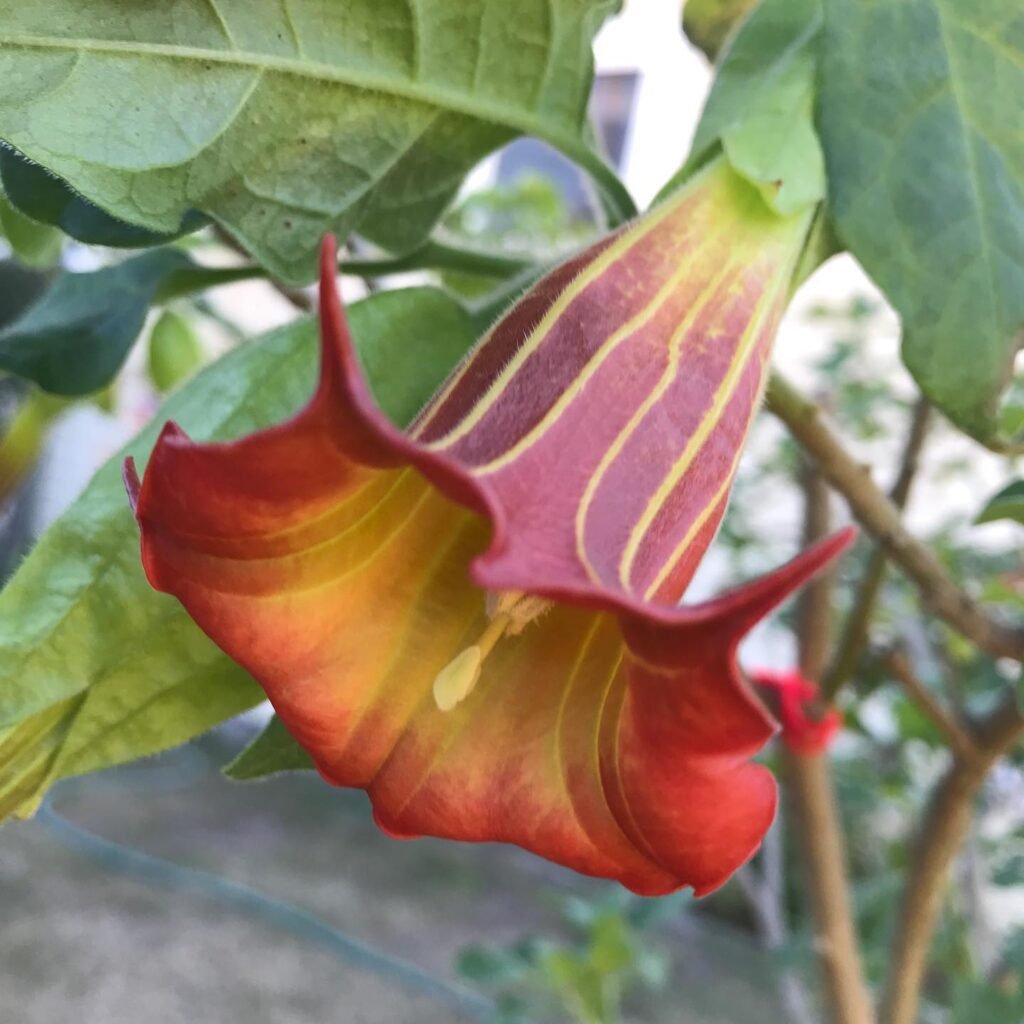
Propagating Brugmansia sanguinea is an exciting way to expand your collection and create new plants to enjoy. There are two main methods for propagating this beautiful shrub: taking softwood cuttings and growing from seeds.
Taking Softwood Cuttings
In spring and autumn, when the plant is actively growing, take softwood cuttings from Brugmansia sanguinea. Cuttings should be around 15cm long, taken from healthy stems. Remove the lower leaves, leaving a few at the top, and dip the cut end into rooting hormone powder to stimulate root growth.
Choose a free-draining compost and fill a pot or tray with it. Insert the cuttings into the compost, ensuring they are firmly planted. Place the pot or tray in a warm spot with bright, indirect light. Keep the compost consistently moist but not waterlogged. Within a few weeks, roots should begin to form, indicating successful propagation.
Growing from Seeds
If you prefer to start from seeds, sow them in spring. Use a heated propagator or cover the pots or trays with a clear plastic bag to create a warm and humid environment. The seeds require warmth to germinate, so ensure the temperature remains around 21-24˚C.
Fill the pots or trays with a seed-starting compost and sow the Brugmansia sanguinea seeds thinly on the surface. Gently press them into the compost, but do not cover them as they need light to germinate. Mist the surface with water to keep it moist and maintain humidity.
Place the pots or trays in a bright location, but avoid direct sunlight. Keep the compost consistently moist but not waterlogged. Germination may take several weeks, so be patient. Once the seeds have germinated and the seedlings have developed their first true leaves, they can be transplanted into individual pots.
Tip: Whether propagating from cuttings or seeds, ensure that you use clean and sterilized tools and pots to minimize the risk of disease or contamination.

Repotting Tips for Brugmansia sanguinea

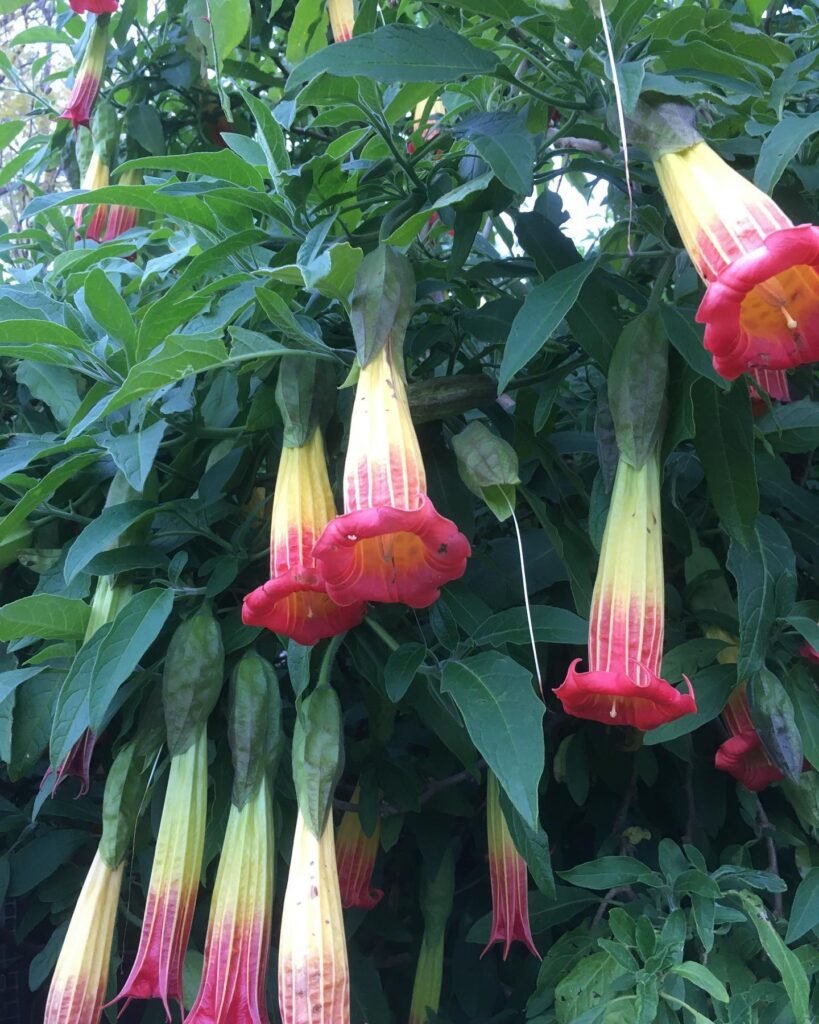
When it comes to Brugmansia sanguinea, or the Red Angel’s Trumpet, repotting every few years is essential for its continued growth and health. Here are some repotting tips to ensure your Brugmansia sanguinea thrives:
Choose the Right Time
Ideally, repot your Brugmansia sanguinea in early spring, just as the plant begins to enter its growth phase. This will allow it to adjust to the new container and soil, and minimize any transplant shock.
Size Matters
Select a slightly larger container to accommodate the growing root system of your Brugmansia sanguinea. This will provide ample space for the roots to spread and absorb nutrients from the soil.
Top-Dressing Option
If increasing the pot size is not feasible, you have the option to top-dress your Brugmansia sanguinea annually in the spring. This involves removing the top layer of compost from the existing container and replacing it with fresh compost. This will help replenish nutrients and promote healthy growth.
Maintain Proper Drainage
When repotting Brugmansia sanguinea, ensure that the new container has proper drainage holes. This will prevent waterlogging and allow excess water to escape, preventing root rot.
Fresh Nutrient-Rich Soil
Use a well-draining soil mix rich in nutrients when repotting Brugmansia sanguinea. A combination of ordinary multipurpose compost and John Innes No. 3 compost in a 50:50 ratio works well. This will provide the plant with the necessary nutrients for healthy growth.
Remember to water your newly repotted Brugmansia sanguinea thoroughly, allowing the water to drain freely. After repotting, place the plant in a suitable spot with adequate sunlight and continue to care for it following the necessary watering and fertilizing routines.
 The Brugmansia sanguinea (Red Angel’s Trumpet) stands out not just for its eye-catching flowers but for thriving in the cooler, high altitudes of South America, rare for tropical plants. It’s ideal for cooler climates, offering exotic beauty without tropical heat.
The Brugmansia sanguinea (Red Angel’s Trumpet) stands out not just for its eye-catching flowers but for thriving in the cooler, high altitudes of South America, rare for tropical plants. It’s ideal for cooler climates, offering exotic beauty without tropical heat.
Toxicity of Brugmansia sanguinea
I want to draw your attention to the important fact that Brugmansia sanguinea, also known as Red Angel’s Trumpet, is a highly toxic plant. Every part of the plant, from its flowers to its leaves, contains toxic compounds that can cause serious illness or even death if ingested. It is crucial to exercise caution when handling Brugmansia sanguinea and to always wear protective gloves to avoid direct contact with its sap.
Not only is Brugmansia sanguinea poisonous when ingested, but the sap of the plant can also cause skin irritation. It is vital to be aware of this potential risk and take necessary precautions to protect your hands and skin.
To ensure the safety of your loved ones, it is advisable to keep Brugmansia sanguinea out of the reach of children and pets. Accidental ingestion of any part of the plant can have severe consequences. It is better to err on the side of caution when it comes to this poisonous plant.
Key Points:
- All parts of Brugmansia sanguinea are highly toxic.
- Ingesting any part of the plant can lead to serious illness or even death.
- The sap of Brugmansia sanguinea can cause skin irritation.
- Handle the plant with gloves to avoid direct contact with the toxic sap.
- Keep Brugmansia sanguinea away from children and pets to prevent accidents.
Best Growing Conditions for Brugmansia sanguinea
Brugmansia sanguinea, commonly known as Red Angel’s Trumpet, thrives in warm and sheltered spots that receive plenty of summer rainfall. To provide optimal growing conditions for Brugmansia sanguinea, it is important to ensure that the plant is watered regularly and adequately, especially in regions with low summer rainfall.
Brugmansia sanguinea can be successfully grown in a variety of garden styles, including exotic-style gardens, Mediterranean gardens, and urban courtyards or patios. Its vibrant blooms and lush foliage make it a beautiful addition to any garden, adding a tropical touch to garden landscaping.
This stunning plant also pairs well with other exotic plants, such as dahlias, creating a visually striking display. With its resilient nature and ability to adapt to different growing conditions, Brugmansia sanguinea can thrive in a range of garden settings, bringing beauty and elegance to any outdoor space.
Overwintering Brugmansia sanguinea
Brugmansia sanguinea, also known as Red Angel’s Trumpet, requires special care during the winter months to ensure its survival. As temperatures drop in autumn, it is important to bring the plant indoors before night temperatures reach 7–10˚C.
There are two methods for overwintering Brugmansia sanguinea: as a houseplant or as a dormant plant. If you choose to keep it as a houseplant, find a warm spot with bright light, such as a conservatory or near a large sunny window. Water sparingly to keep the plant in leaf during the winter.
Alternatively, you can overwinter Brugmansia sanguinea as a dormant plant. Find a cool, dark location with minimal or no light, such as a cellar or garage. Water sparingly to keep the compost slightly damp, but be careful not to overwater.
In spring, as the days get longer and temperatures start to rise, you can bring the plant back into growth by gradually increasing watering and moving it into good light. This will help the plant transition from its dormant state and encourage new growth and flowering.
Helpful Videos about Growing Brugmansia sanguinea
Thinking about giving Brugmansia sanguinea (Red Angel’s Trumpet) a go? I’ve rounded up a few handy videos for you. They offer straightforward advice to guarantee your plant thrives, from key care tips to nifty tricks. Perfect for green thumbs and beginners alike, these guides are all about simplifying the care for Red Angel’s Trumpet, ensuring a rewarding gardening experience.
- How to grow Brugmansia sanguinea – the Angel’s Trumpet – a cool climate species of this great plant!
- BRUGMANSIA SANGUINEA FROM SEED
- How to Grow Brugmansia sanguinia – The Red Angel’s trumpet
FAQ about Growing Brugmansia sanguinea (Red Angel’s Trumpet)

Fancy turning your Brugmansia sanguinea (Red Angel’s Trumpet) into a bit of a marvel? Dive into my easy-to-follow FAQ for all the advice you need on caring for your Brugmansia sanguinea. Whether it’s picking the perfect spot outdoors or getting the watering just right, I’ve covered all bases to help it thrive.
Choose a spot with full to partial sunlight and shelter from strong winds to protect its delicate foliage and blooms.
Water it deeply when the top layer of soil feels dry to the touch. It prefers consistently moist soil but dislikes waterlogging.
It thrives in well-draining, fertile soil. A mix of garden soil, peat, and perlite or sand can improve drainage and soil structure.
Feed it with a balanced, water-soluble fertiliser every two weeks during the growing season for lush growth and abundant flowering.
Absolutely! Ensure the pot is large enough and has good drainage holes. Potted plants may require more frequent watering and fertilising.
Prune in late winter or early spring to shape the plant and encourage bushier growth. Remove any dead or damaged branches to keep it healthy.
No, it’s not frost-tolerant. Provide protection in winter or move potted plants indoors if temperatures drop below freezing.
Ensure it gets enough sunlight, keep the soil moist, and fertilise regularly. Pruning can also stimulate more vigorous flowering.
Spider mites and whiteflies can be problematic. Use insecticidal soap or neem oil to control these pests.
Yes, all parts of the plant are toxic if ingested. Keep it away from pets and children and handle with care.
Propagate through cuttings taken in spring or summer. Plant them in a moist, well-draining soil mix and keep in indirect light until rooted.
Yellow leaves can be a sign of overwatering, poor drainage, or nutrient deficiency. Check soil moisture and adjust your care accordingly.
With proper care, it can flower in its first year, especially if grown in optimal conditions and started early in the season.
Yes, its fragrant flowers attract pollinators like bees and hummingbirds, adding more life to your garden.
Yes, it can be grown indoors in a well-lit area, such as near a south-facing window, but it may not flower as profusely as it would outdoors.
Lack of blooms can be due to insufficient light, over or under-watering, or lack of nutrients. Ensure it’s getting enough sunlight, and consider adjusting your watering and feeding routine.
Regular pruning can control its size. You can prune it back heavily in late winter without harming the plant, as it will regrow vigorously in spring.
I hope this has cleared up how to care for your Brugmansia sanguinea (Red Angel’s Trumpet). Any lingering questions? Drop them in the comments, and I’ll pop back with an answer. Remember, every gardener begins at the starting line, and learning the ins and outs of your Red Angel’s Trumpet is a brilliant journey.

